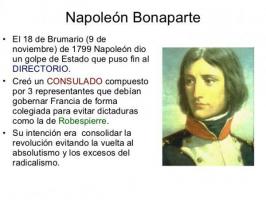History of the Spanish War of Independence
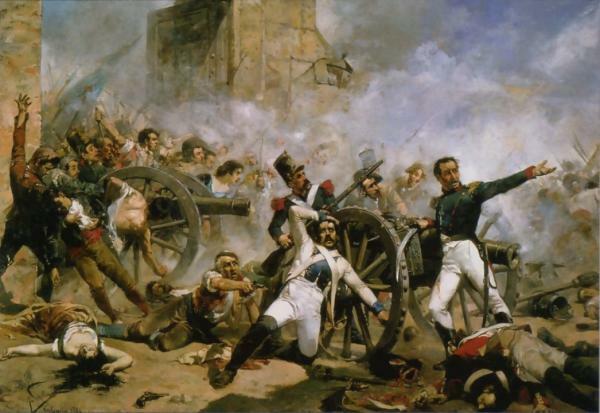
After the defeat at Trafalgar of the French and Spanish troops before the naval might of Great Britain, they produced a series of events that would lead to the kingdom of Spain falling into dependence on France Napoleonic. This would be endorsed after the Treaty of Fointaineblau whereby Spain allowed the passage of French troops through Spanish territory to conquer the neighboring kingdom of Portugal. In this lesson from a TEACHER we will do a summary of the history of the Spanish War of Independence, which consisted of a series of warlike confrontations between the Spanish patriots and the French who had settled in the kingdom of Spain between the years 1808-1814.
Index
- The prelude to French rule
- The uprisings of May 2
- The battle of Bailén
- The French retreat to the Pyrenees
- The years of domination 1809-1812
- The end of French rule
- The consequences of war
The prelude to French rule.
With the Treaty of Fointaineblau that occurred on October 27, 1807, a large French contingent arrived in Spain, approximately some
65,000 men for the subsequent invasion of the kingdom of Portugal. These troops, in addition to settling on the main communication routes with Portugal, were stationed in Madrid and on the border with France.Given this, the Royal family decided to go to the palace of Aranjuez, for a possible evacuation to the American colonies if necessary. But 1March 7, 1808, in that same place the well-known Mutiny of Aranjuez, which made Ferdinand VII come to the throne of Spain, forcing his father, Carlos IV, to abdicate in his favor.
In this way, and thanks to the political power vacuum, on March 23, Madrid was occupied by General Murat. After this, Napoleon sent for the suitors of the Spanish throne to “settle the dispute”, obtaining from them on May 5, 1808, the Spanish Crown, which was handed over to his brother. Joseph I Bonaparte.
In this other lesson from a TEACHER we will discover a short biography of Napoleon.
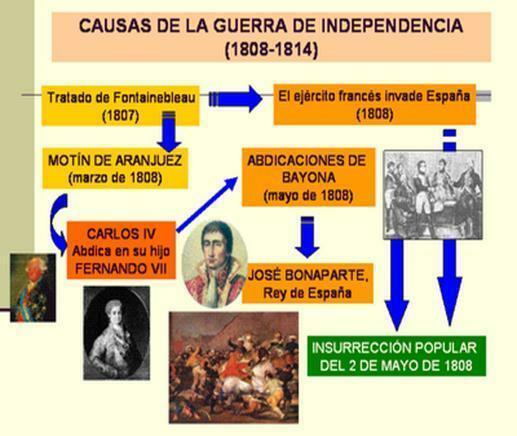
Image: HUGO'S BLOG - blogger
The uprisings of May 2nd.
We continue with this summary of the history of the Spanish War of Independence speaking, now, of what happened on May 2. Even before Napoleon obtained the Spanish Crown, a series of uprisings against the invaders began in Spain.
In fact, the May 2, 1808 there was a general uprising in Madrid with people from many parts of the Peninsula. Possibly these uprisings were produced because a short time ago, the kingdom had suffered a period of great famine, an element that played against the greedy French, who were simply one more burden for the people.
Thus we must highlight a series of riots that occurred in Burgos or León, where citizens reproached the government for the impossibility of maintaining foreign troops. Quickly the uprising was stopped by the Napoleonic army, which was very well equipped, making it impossible for the exalted citizens to have much to do. Thus, the On May 3, 1808, the famous executions took place, which were reflected in the paintings of Francisco de Goya, in these a great number of Spaniards were assassinated.
After this, the news of the uprising in Madrid and the repression against the Spanish by France became known throughout the kingdom, creating a series of boards (we can say that they were a series of governments that were created in the absence of the central government), which were uniting to face the invasive.
So we will find the first meeting on May 22 in Cartagena, in that way they were uniting, until creating the central board of Spain and the Indies in Seville, from which a series of military attacks against the French would begin to orchestrate.
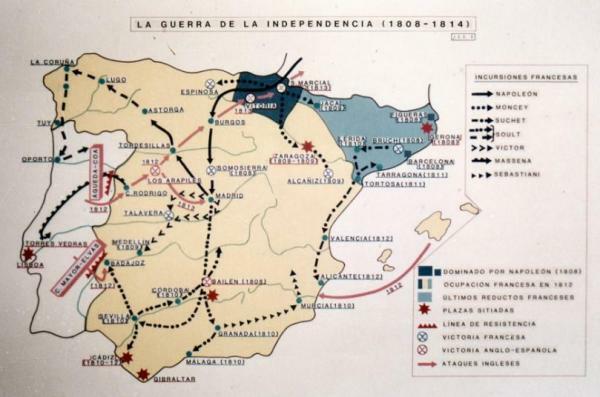
Image: History with Maps
The battle of Bailén.
The Supreme Board of Spain and the Indies and the Granada Board would jointly carry out the creation of two armies, whose objective was drive out the french of the Spanish territory. Thus appeared on the scene the army of Andalusia and the Swiss regiment of Reding.
The French viewed with suspicion how a series of foci reluctant to their control had arisen throughout the peninsula, being Andalusia the most important focus. For this reason, from Madrid it was decided to send Dupont, who had the order to submit Andalusia. From Madrid to the Despeña Perros pass, the French troops suffered the suffocating heat during the days. from the constant attacks of the bandits who, protected by the mountains, made it almost impossible for them to be caught.
On June 8, 1808 they arrived in Córdoba French troops, which was brutally looted. While the French troops were still in the old Caliphal capital, the surrender of the French squad stationed in Cádiz was announced, in addition to have news about the armies of Andalusia, a fact that caused him to withdraw from Córdoba seeking refuge in Andújar while waiting for new props.
Continuing with our summary on the History of the War of Independence of Spain, we must focus on one of the most important events for contemporary history, since the Battle of Bailén, was the first defeat of the Napoleonic army in open field.
Thus, between July 18 and 22, 1808, the two armies clashed in the vicinity of Bailén, the Spanish being somewhat more numerous with about 27,000 men while the French had 21.000. The victory in Andalusia gave a strong respite to the Juntas that had been created in Spain, in addition to give a wake-up call to the emperor, who, upon learning of the defeat, had to take letters in the affair.

The French retreat towards the Pyrenees.
Between June and November 1808, the French suffered a series of defeats as happened in Zaragoza, which lasted between June 15 and August 15, or the entry into Madrid of General Castaños on August 5. September.
Because of this, the Napoleonic army together with José I was forced to move north of the Ebro where they awaited the arrival of the emperor with the Grande Armée (250,000 very well equipped troops).
So until November 2, 1808 Napoleon arrived in Bayonne, where he regrouped and reorganized the troopsIn addition to bringing with him the best of his army, which he divided in two to take Spain and Portugal from north to south, eliminating all resistance in his wake.
The years of domination 1809-1812.
After the arrival of Napoleon everything changed, for there was defeat after defeat for the patriotic side. Thus they arrived in Ocaña in November 1809, forcing the Central Board to march to Seville and after the advance of the French they were forced to move to Cádiz.
From there began the gestation of a series of treaties between other European kingdoms for a joint attack that would end Napoleon's rule over Europe. Until 1812, we will only find a series of skirmishes between the guerrillas and the French troopssThese scattered attacks were aimed at ending enemy supply lines, rather than creating casualties, we can call it a war of attrition.
In the summer of 1812 the battle of the Aralipes took place, which forced José I to march to Madrid, losing control of Andalusia.
The end of the French domination.
After the battle of Aralipes, the entry into action of the joint forces between the British, the Portuguese and the Spanish against the French was decisive for their expulsion. Little by little they were losing all the places they had in Spain, being the last battle that occurred in Vitoria on June 21, 1813, After the victory of the Spanish troops, the French and José I were expelled from the Peninsula, although until March 22, 1814, the monarch Fernando VII could not return to Spain.
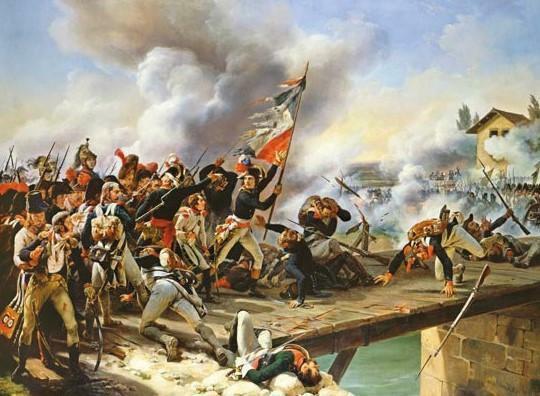
Image: DaTuOpinion.com
The consequences of war.
To conclude with our summary on the History of the War of Independence of Spain, we will have to know a series of elements that were forged at that time. In the military sphere, the guerrilla warfare, which were made up of bandits and peasants that they hardly knew military tactics, but nevertheless they knew perfectly the terrain through which they moved, making it very difficult for them to be found.
In addition, they had the help of the people, who protected them. We can affirm without mistake that it was the guerrillas who helped Spain to finish off the French, since the fact of cutting the supply lines greatly reduced the Napoleonic troops.
Another of the key points that occurred during the war of independence was the emergence of a very strong liberal sector, which obtained a lot of power and was the one that caused the creation of the Constitution of 1812 "La Pepa", and that laid the foundations for what would later become the Spanish liberal system. Although it would be necessary to wait for the death of Fernando VII in 1833 for its implantation.
Concluding with this we must mention the catastrophe for the economy Spanish the fact of such a long and bloody war. For between 1808-1814 there was the destruction of most of the country's industry at the hands of the troops French and British, above all, making the country after its liberation not have the elements to resurface from its ashes.
In addition, and not least, we must know that, during the conflict, the colonies began the process of emancipation, losing contact with them and therefore they stopped receiving the galleons from them.
If you want to read more articles similar to History of the War of Independence of Spain - Summary, we recommend that you enter our category of Story.



